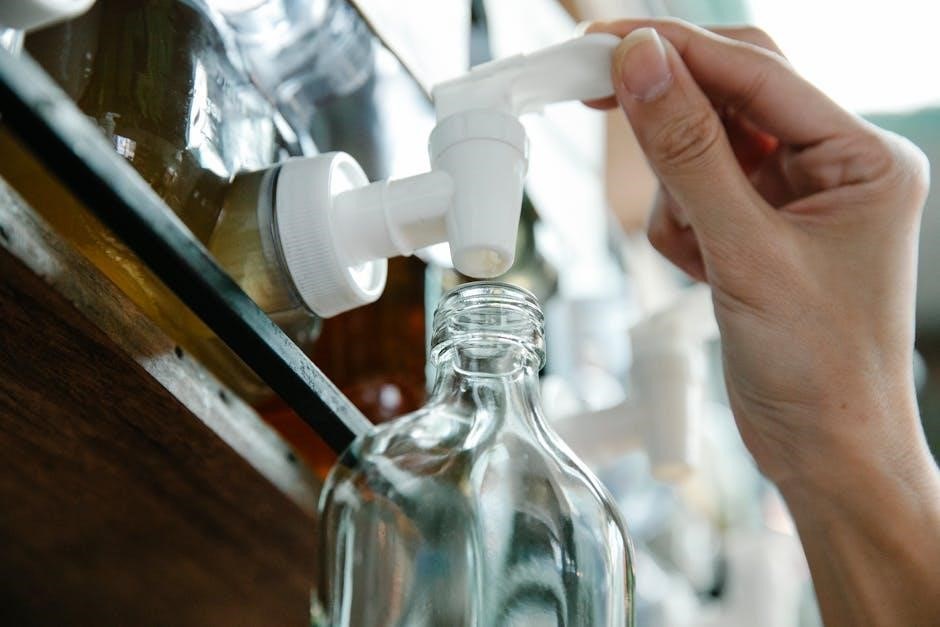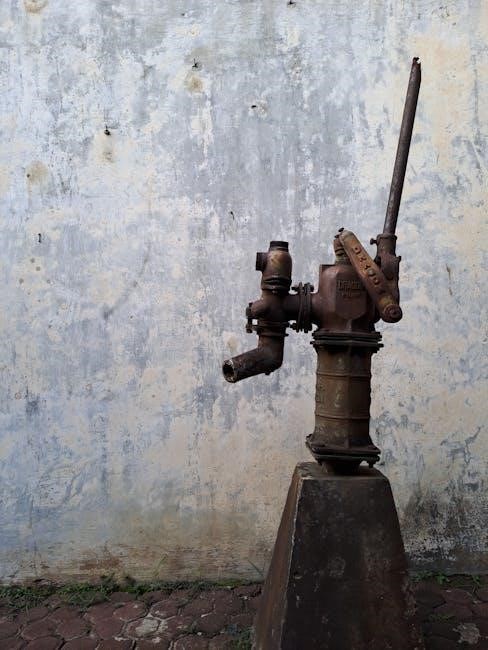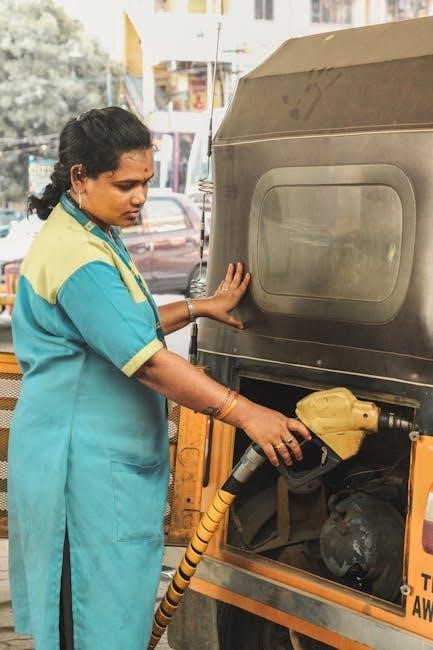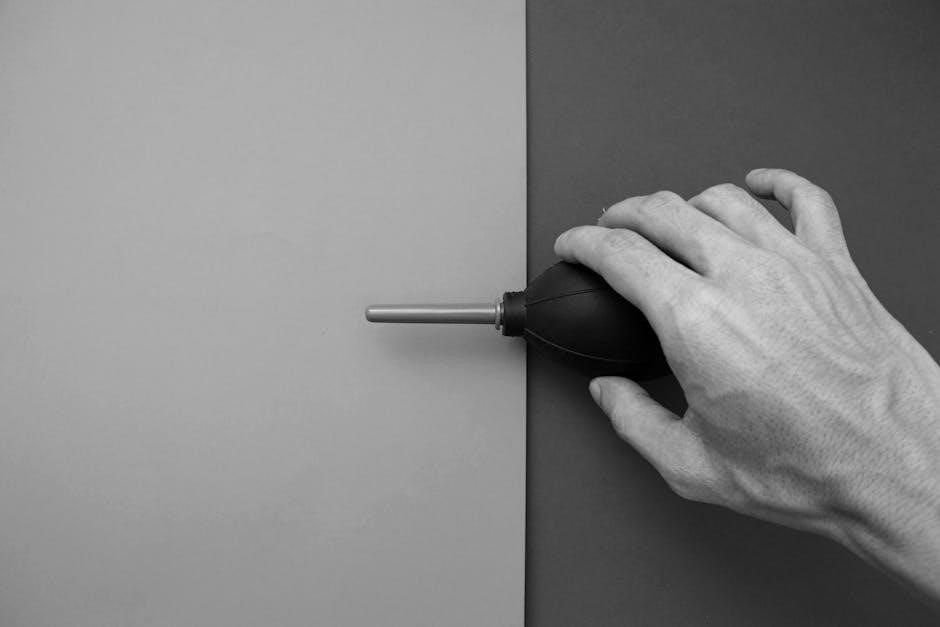The CAV Injector Pump Manual PDF is a comprehensive guide for understanding, maintaining, and repairing CAV fuel injection systems. It covers installation, troubleshooting, and advanced repair techniques, ensuring optimal performance and longevity of the pump.
Overview of the CAV Injector Pump
The CAV Injector Pump is a compact, oil-tight unit designed for diesel fuel injection systems. It operates without ball or roller bearings, gears, or highly stressed springs, ensuring reliability and simplicity. The pump features a governor, either mechanical or hydraulic, to maintain precise speed control. This design allows for sensitive fuel regulation, making it suitable for various diesel engines. The pump distributes fuel to multiple cylinders through individual injection nozzles, ensuring efficient combustion. Its construction emphasizes durability and minimal maintenance, with a focus on consistent performance under varying conditions. The CAV Injector Pump is widely used in marine, agricultural, and industrial applications, highlighting its versatility and dependability in fuel delivery systems.
Importance of the Manual for Maintenance and Repair
The CAV Injector Pump Manual PDF is essential for maintaining and repairing the pump effectively. It provides detailed instructions for disassembly, inspection, and reassembly, ensuring proper handling of sensitive components. The manual includes torque specifications, alignment guides, and safety precautions to prevent damage and ensure optimal performance. By following the manual, users can identify and address common issues like leaks, low fuel pressure, and noise. It also covers the replacement of wear-and-tear parts, such as oil seals and gaskets, which are critical for maintaining the pump’s efficiency. Additionally, the manual offers troubleshooting tips and step-by-step repair processes, making it an invaluable resource for both novice and experienced technicians. Regular reference to the manual helps extend the pump’s lifespan and reduces downtime, ensuring reliable fuel injection system operation.
Key Features of the CAV Injector Pump Manual PDF
The CAV Injector Pump Manual PDF is a detailed and comprehensive resource designed to assist users in understanding and working with the CAV injector pump. It includes step-by-step guides for installation, disassembly, and reassembly, along with torque specifications and alignment instructions. The manual features interactive parts diagrams, which help users identify and locate components easily. Additionally, it provides troubleshooting tips for common issues such as leaks, low fuel pressure, and noise. The document also emphasizes safety precautions to ensure safe handling of the pump and its components. With its clear instructions and detailed illustrations, the manual is an invaluable tool for both professional technicians and DIY enthusiasts. It covers essential maintenance tasks, such as regular inspections and replacing wear-and-tear parts, ensuring the pump operates efficiently and reliably over time.

Key Components of the CAV Injector Pump
The CAV Injector Pump consists of a durable pump housing, internal mechanisms, a precise drive mechanism, and a coupling for power transmission. It also features fuel injection nozzles and critical elements for efficient fuel delivery.
Pump Housing and Internal Mechanisms

The pump housing of the CAV injector pump is a robust, oil-tight unit designed to withstand the rigors of fuel injection systems. It contains the suction chamber and pumping chambers, which are essential for fuel flow and pressurization. The housing is constructed from durable materials to ensure longevity and resistance to corrosion. Inside, the pump relies on vanes or blades to create the necessary pressure for fuel injection. These internal components are precisely engineered to ensure efficient fuel delivery. The manual provides detailed diagrams and instructions for inspecting and maintaining these critical parts. Proper alignment and torque specifications are emphasized to prevent damage during repairs. The design avoids complex bearings or gears, simplifying maintenance and reducing wear points. Regular inspection of the housing and internal mechanisms is crucial for identifying leaks or wear, ensuring optimal performance and preventing costly breakdowns.
Drive Mechanism and Coupling
The drive mechanism of the CAV injector pump is designed to transfer power from the engine to the pump efficiently. It typically connects to the engine’s timing gear, ensuring precise synchronization for fuel delivery. The coupling is a critical component, requiring proper alignment and torque to prevent damage. The manual emphasizes the importance of using the correct oil seals, such as the CAV Lucas 5393-252R, which are often not included in standard rebuild kits. These seals are essential for preventing leaks and ensuring smooth operation. The drive mechanism is free from complex bearings or gears, simplifying maintenance; Proper installation and alignment are crucial to avoid vibration or noise. The manual provides detailed torque specifications and steps for securing the coupling, ensuring reliable performance and longevity of the pump. Regular inspection of the drive mechanism is recommended to identify wear or misalignment early.
Fuel Injection Nozzles and Elements
The fuel injection nozzles and elements are vital components of the CAV injector pump, responsible for delivering fuel precisely into the engine. These components must be inspected regularly for wear, damage, or clogging, as they directly impact engine performance. The manual provides detailed steps for dismantling, cleaning, and replacing these parts. Proper timing and alignment of the nozzles are critical to ensure efficient fuel delivery and prevent engine misfires. The manual also covers the inspection of pump blades or vanes, which play a key role in fuel distribution. Replacing worn or damaged elements with genuine parts, such as those from the CAV injector pump rebuild kit, is essential for maintaining optimal performance. The guide emphasizes the importance of following torque specifications and safety precautions when handling these components to avoid further damage or safety risks. Regular maintenance of these elements ensures reliable fuel injection and engine operation.

Installation and Setup Guidelines
Proper installation of the CAV injector pump requires precise alignment and torque specifications to ensure optimal performance. Use specialized tools and follow the manual’s step-by-step guide for accurate setup and configuration.

Step-by-Step Installation Process
Installing the CAV injector pump requires careful preparation and adherence to the manual’s guidelines. Begin by gathering all necessary tools and components, including the rebuild kit, oil seals, and gaskets. Ensure the pump housing is clean and free from debris. Align the pump with the engine’s drive mechanism, securing it with the specified torque values. Connect the fuel supply line, ensuring proper filtration and flow. Install the injection nozzles, tightening them to the recommended torque specifications. Finally, test the system for leaks and proper fuel pressure before starting the engine. Refer to the manual for detailed diagrams and step-by-step instructions to ensure a successful installation.
Tools and Equipment Required
Proper tools and equipment are essential for a successful CAV injector pump installation. A torque wrench, socket set, and screwdrivers are fundamental for securing components to the correct specifications. Specialized tools, such as a seal installation tool, are necessary for fitting oil seals and gaskets without damage. A fuel pressure test kit ensures the system operates within the required range. Cleaning supplies, like solvent and lint-free cloths, are crucial for preparing surfaces and preventing contamination. Additionally, a set of precision measuring tools, such as a micrometer, may be needed for inspecting parts. Refer to the manual for a detailed list of tools and equipment, as some components may require specific adapters or wrenches. Ensure all tools are in good condition to avoid rounding bolts or damaging sensitive parts during installation.
Torque Specifications and Alignment
Proper torque specifications and alignment are critical for the correct installation and operation of the CAV injector pump. The manual provides detailed torque values for bolts, connections, and other components to ensure structural integrity and prevent damage. Misaligned components can lead to poor performance, leaks, or premature wear. Use a torque wrench to secure bolts in the specified sequence, starting with peripheral fasteners and moving inward. Alignment of the drive mechanism and coupling is equally important to maintain smooth operation and avoid vibration. Refer to the manual for precise torque values and alignment procedures, as these vary depending on the pump model and application. Proper adherence to these guidelines ensures optimal fuel delivery, reduces wear on moving parts, and extends the lifespan of the pump. Always double-check alignment and torque settings before finalizing the installation.

Troubleshooting Common Issues
The CAV Injector Pump Manual PDF provides detailed guidance for diagnosing and resolving common issues such as leaks, low fuel pressure, and noise or vibration, ensuring efficient problem-solving.
Identifying Leaks and Seepage Points
Identifying leaks and seepage points in the CAV injector pump is crucial for maintaining its efficiency and preventing further damage. The CAV Injector Pump Manual PDF provides detailed steps to locate and address these issues. Start by visually inspecting the pump housing, fuel lines, and connections for any signs of moisture or discoloration. Pay particular attention to the drive axle seals, as they are common sources of leaks. Use a pressure test kit to identify seepage in the fuel system, ensuring the pump is under operational pressure. Additionally, check the gaskets and O-rings, especially around the inlet and outlet ports, as these areas are prone to wear. The manual also recommends inspecting the pump blades and vanes for damage, which can lead to internal leaks. By following these guidelines, you can pinpoint and resolve leaks effectively, ensuring optimal pump performance and longevity.
Diagnosing Low Fuel Pressure
Diagnosing low fuel pressure in the CAV injector pump requires a systematic approach, as outlined in the CAV Injector Pump Manual PDF. Begin by ensuring the fuel supply is adequate, checking the fuel tank level and filter for blockages. Inspect the fuel lines for any signs of leaks, kinking, or damage, which can restrict flow. Use a pressure gauge to measure fuel pressure at the inlet and outlet of the pump, comparing the readings to the manufacturer’s specifications. If pressure is low, inspect the pump’s internal components, such as the blades and vanes, for wear or damage. Additionally, check the drive seals and gaskets for any signs of leakage or deterioration. The manual also recommends performing a pressure test on the pump to identify any internal issues. Addressing these problems promptly ensures proper fuel delivery and prevents engine performance issues. Regular maintenance, as detailed in the manual, can help prevent low fuel pressure scenarios.
Addressing Noise or Vibration
Noise or vibration in the CAV injector pump can indicate underlying issues that require immediate attention. According to the CAV Injector Pump Manual PDF, common causes include worn or damaged drive seals, misalignment of the pump, or loose couplings. Start by inspecting the drive mechanism and coupling for any signs of wear or play. Ensure all bolts and fasteners are tightened to the specified torque values, as outlined in the manual. If noise persists, check the pump housing for any internal damage or debris. Proper alignment of the pump with the engine is crucial to minimize vibration. The manual also recommends using a pressure gauge to verify fuel pressure, as low pressure can sometimes manifest as unusual noise. Regular inspection and maintenance, such as replacing worn seals or gaskets, can help prevent these issues. Always refer to the manual for detailed diagnostic steps and repair procedures.

Maintenance and Service Schedule
Regular inspection and cleaning of the CAV injector pump are essential for optimal performance. Replace wear and tear parts, such as seals and gaskets, as recommended in the manual.
Regular Inspection and Cleaning
Regular inspection and cleaning of the CAV injector pump are crucial for maintaining its efficiency and preventing premature wear. Start by examining the pump housing for any signs of leaks or damage. Clean the fuel inlet and outlet connections to ensure proper flow. Use a soft-bristle brush to remove dirt and debris from the exterior surfaces. Pay special attention to the fuel injection nozzles, as they are prone to clogging. Soak them in a cleaning solution and use compressed air to clear any blockages. Inspect the drive seals and gaskets for wear, replacing them if necessary. Refer to the manual for torque specifications when reassembling components. Regular cleaning prevents fuel contamination and ensures optimal performance. Schedule inspections every 500 hours of operation or as recommended in the manual to maintain reliability and extend the pump’s lifespan.

Replacing Wear and Tear Parts
Replacing wear and tear parts in the CAV injector pump is essential to maintain its performance and prevent costly repairs. Key components to replace include the pump blades, vanes, and seals. The CAV injector pump rebuild kit (e.g., 7135-70/7135-110) provides most necessary parts, but some items like oil seals for the drive axle must be ordered separately. Ensure to use genuine or high-quality replacement parts to avoid compatibility issues. Refer to the manual for torque specifications and reassembly instructions. Regularly replacing worn parts prevents fuel leaks, low pressure, and noise. Always follow proper disassembly and cleaning procedures before installing new components. Proper replacement ensures the pump operates efficiently, maintaining fuel flow and engine performance. Keep a record of replaced parts and their manufacturer to track maintenance history effectively.
Safety Precautions During Maintenance
When performing maintenance on the CAV injector pump, it is crucial to follow safety precautions to avoid accidents and ensure proper repair; Always turn off the engine and disconnect the battery before starting work. Wear protective gear, including gloves and safety glasses, to prevent injury from sharp edges or fuel splashes. Ensure the work area is well-ventilated to avoid inhaling harmful fumes. Never smoke or use open flames near the pump, as fuel vapors can ignite. Use proper tools to avoid damaging components, and keep a fire extinguisher nearby. Handle fuel and hydraulic fluids with care, as they can be hazardous to skin and eyes. Refer to the manual for specific safety guidelines, and if unsure, consult a professional. Proper safety practices ensure a safe and effective maintenance process. Always prioritize caution when working with fuel systems.

Advanced Rebuild and Repair Techniques
The CAV Injector Pump Manual PDF provides detailed steps for advanced rebuilds, including specialized tools and precision techniques to ensure optimal performance and longevity of the fuel injection system.
Disassembling the Pump for Repair
Disassembling the CAV injector pump requires careful planning and specialized tools to avoid damage. Start by removing the drive mechanism and coupling, ensuring the pump is clean and free from debris. Next, disconnect the fuel injection nozzles and elements, taking note of their positions for reassembly. The pump housing should be opened cautiously, revealing internal components such as blades, vanes, and seals. Use torque wrenches to remove bolts, adhering to specified torque values to prevent stripping threads. Handle sensitive parts with care, as they are prone to wear and damage. Refer to the CAV Injector Pump Manual PDF for detailed disassembly steps, including diagrams and torque specifications. Proper disassembly is crucial for effective repair and ensures the pump operates efficiently post-reassembly. Always follow safety guidelines to avoid injury and maintain the integrity of the fuel system.
Inspecting and Replacing Internal Components
Inspecting and replacing internal components of the CAV injector pump is critical for ensuring proper functionality. Begin by examining the pump blades and vanes for wear or damage, as these are essential for fuel distribution. Check the oil seals and gaskets for any signs of leakage or degradation, replacing them if necessary. The fuel injection nozzles and elements should also be inspected for clogging or corrosion, as these can significantly affect fuel flow and engine performance. Use the CAV Injector Pump Manual PDF to identify and source genuine replacement parts, such as the CAV Lucas 5393-252R DPA injection pump drive seals, which are often not included in standard rebuild kits. Ensure all components are cleaned thoroughly before reassembly. Adhere to the manual’s guidelines for torque specifications and alignment to maintain the pump’s integrity and performance. Proper inspection and replacement of internal parts are vital for preventing future issues and ensuring reliable operation.
Reassembling and Testing the Pump
Reassembling the CAV injector pump requires precision to ensure proper functionality. Start by carefully aligning the internal components, such as the pump blades and vanes, according to the CAV Injector Pump Manual PDF. Tighten all connections to the specified torque values to avoid damage or leakage. Once reassembled, perform a thorough test to check for leaks, unusual noises, or vibrations. Use a fuel supply from a tank positioned higher than the pump to ensure smooth flow and pressure. Test the pump under various operating conditions to verify consistent performance. If issues arise, refer to the manual’s troubleshooting section for guidance. Novice users should consider seeking assistance from experienced mechanics to avoid costly mistakes. Proper reassembly and testing are crucial for restoring the pump’s efficiency and reliability. Always follow the manual’s instructions to ensure safety and optimal results.

Resources and References
Key resources include the Lucas CAV DPA Injection Pump Instruction Book and the CAV DPA Pump Rebuild Manual PDF. Interactive parts diagrams and repair guides are also available online for detailed reference.
Recommended Manuals and Guides
For comprehensive guidance, the Lucas CAV DPA Injection Pump Instruction Book is essential. It provides detailed instructions for installation, troubleshooting, and repair. Additionally, the CAV DPA Pump Rebuild Manual PDF offers step-by-step disassembly, inspection, and reassembly procedures. Both manuals include torque specifications, parts diagrams, and safety tips. The CAV Injector Pump Manual PDF is another valuable resource, covering fuel system maintenance and advanced repair techniques. These documents are available on platforms like Scribd and injectionpumps.co.uk. They are indispensable for professionals and DIY enthusiasts alike, ensuring proper handling and optimization of the CAV injector pump system.
Interactive Parts Diagrams and Tools
Interactive parts diagrams are invaluable for identifying and ordering components for the CAV injector pump. Websites like injectionpumps.co.uk provide detailed, clickable diagrams that allow users to explore each part of the pump. These tools are especially useful for DIY enthusiasts and professionals alike, ensuring accurate identification of components like oil seals, gaskets, and vanes. Additionally, the CAV DPA Pump Rebuild Manual PDF often includes exploded views and part numbers, making it easier to source replacement parts. These resources, combined with torque specifications and step-by-step guides, streamline the maintenance and repair process, reducing errors and saving time. They are essential for anyone working with the CAV injector pump system.
Online Communities and Forums
Online communities and forums are excellent resources for troubleshooting and discussing the CAV injector pump. Websites like injectionpumps.co.uk and Scribd offer forums where users can share experiences, ask questions, and access shared knowledge. These platforms are particularly useful for DIY enthusiasts and professionals seeking advice on specific issues, such as rebuilding or repairing the pump. Many forums also provide links to manuals, diagrams, and repair guides, making them a one-stop resource for CAV injector pump maintenance. Additionally, YouTube channels and specialized groups often feature step-by-step tutorials and tips for common repairs, fostering a collaborative environment for learning and problem-solving. Engaging with these communities can significantly enhance your understanding and effectiveness in working with the CAV injector pump system.
The CAV Injector Pump Manual PDF is a vital resource for effective use and maintenance, ensuring optimal performance and longevity through detailed guidance and proper documentation;
Final Tips for Effective Use and Maintenance
For optimal performance, always use genuine CAV injector pump rebuild kits and ensure all components are properly aligned and torqued. Regularly inspect fuel lines and connections to prevent leaks. Clean or replace filters as recommended to maintain fuel flow. Refer to the CAV Injector Pump Manual PDF for specific torque values and disassembly steps. Keep a spare set of oil seals and gaskets on hand, as they are critical for preventing seepage. When reassembling, double-check all parts for wear and ensure proper seating of blades and vanes. Follow safety precautions to avoid fuel exposure and electrical hazards. Document your maintenance activities for future reference. By adhering to these guidelines, you can extend the lifespan of your CAV injector pump and ensure reliable engine operation. Stay informed through online forums and manuals for the latest tips and troubleshooting advice.
Encouragement for Further Learning
Exploring the CAV Injector Pump Manual PDF is just the beginning of mastering fuel injection systems. Dive deeper by studying detailed guides, such as the CAV DPA Pump Rebuild Manual, to gain hands-on experience. Watch instructional videos and join online forums to learn from experts and enthusiasts. Experiment with rebuild kits like the 7135-70/7135-110 to familiarize yourself with internal components. Engage in DIY projects, such as resealing pumps or replacing wear parts, to build confidence. Explore interactive parts diagrams to visualize assembly processes. Share your experiences and ask questions in communities to refine your skills. Continuous learning ensures you stay updated on best practices and troubleshooting techniques, making you proficient in maintaining and repairing CAV injector pumps. Embrace the journey of understanding diesel fuel systems for long-term success in engine maintenance and repair.
Importance of Proper Documentation
Proper documentation is crucial when working with the CAV Injector Pump Manual PDF. Keeping detailed records of maintenance, repairs, and replacements ensures consistency and accuracy. Documenting torque specifications, part numbers, and repair steps helps prevent errors during future servicing. Referencing manuals like the CAV DPA Pump Rebuild Manual provides clear guidelines for disassembly, inspection, and reassembly. Maintaining a log of fuel system performance and filter changes can help identify trends and potential issues early. Proper documentation also aids in compliance with manufacturer recommendations and safety standards. By organizing your notes and referencing official guides, you ensure that repairs are done correctly, reducing the risk of costly mistakes. Always keep a copy of the CAV Injector Pump Manual PDF and related resources handy for quick access during maintenance tasks.
